© ROOT-NATION.com - Use of content is permitted with a backlink.
Finally, we have been waiting! Poland is ready to transfer a company of Leopard 2 battle tanks to Ukraine. Today we will tell you about this modern tank.
The news that the famous German Leopard 2 tanks would finally arrive in Ukraine quickly spread across the media not only in Ukraine but around the world. The fact is that this is the first time our Western partners have agreed to provide our Armed Forces with combat tanks. These are the weapons we need now to resist the Russian invasion, these are the weapons we need for defense and counteroffensive operations to liberate the temporarily occupied territories. Everyone has been asking for it for a long time, but the process was delayed for several months. And now it has happened. Yes, so far it is only a company of battle tanks, i.e. only 14 vehicles, but this is just the beginning. The UK government has also decided to share its Challenger 2 tanks with us. We hope that other allies will not stand aside either.
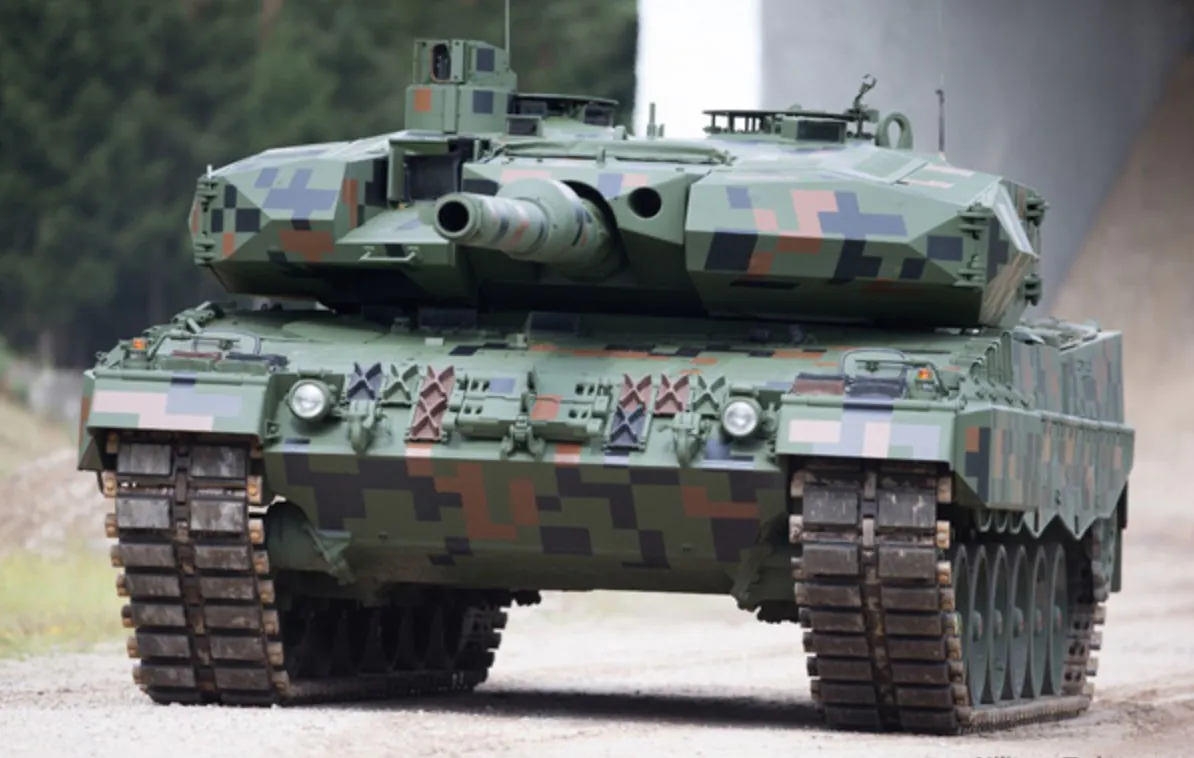
Today we would like to tell you about the legendary Leopard 2 battle tank, its history, variants, and armament. We will pay special attention to the Leopard 2PL version, which is in service with the Polish Army, so it is likely that they will be the first to arrive in Ukraine.
Read also: Weapons of Ukrainian Victory: German Gepard Self-Propelled AA Gun

The most successful tank of the Cold War
The Leopard 2 is a German-made main battle tank developed and manufactured by Krauss-Maffei Wegmann, the successor to the Leopard 1 main battle tank. The Leopard 2A4 version is the basis of the modern Leopard family.
The Leopard 2 was and is considered to be the hallmark of German tank production. Its development could be considered a continuation of the traditions of the best examples of the former German Wehrmacht. However, this was not a given, as several postwar models of German armored vehicles were unsuccessful. For example, the HS 30 infantry fighting vehicle was frankly unsuccessful, its production was accompanied by corruption scandals, and at the time of construction, this cannon fighter was already outdated.
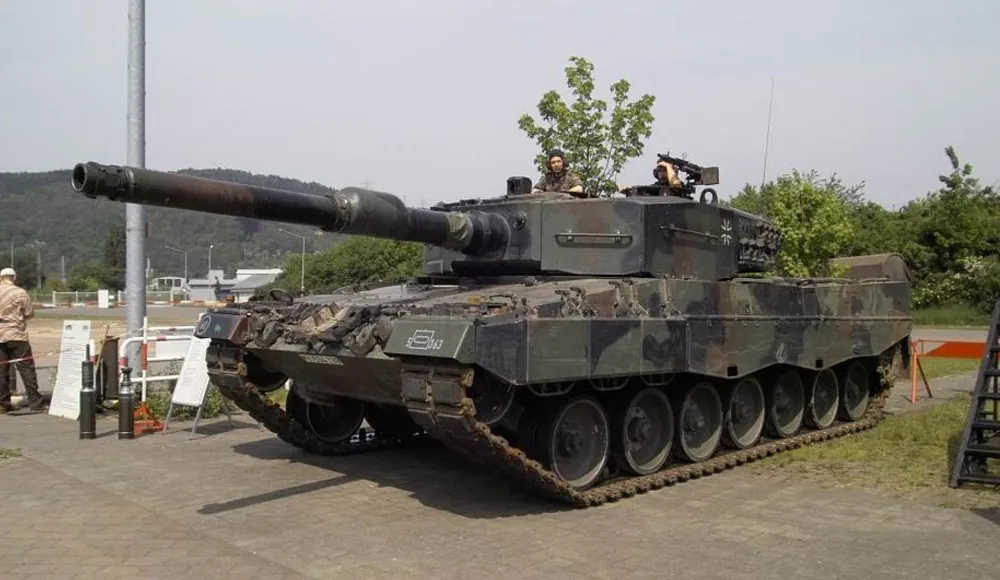
Of course, none of this applies to the Leopard 1. However, the first postwar tank did not impress with its armor reliability. It was reduced to the bare essentials. At the time the tank was conceptualized, it was believed that the so-called heat-seeking projectiles, which cut through steel with a jet of hot plasma, would still penetrate any armor, so it seemed pointless to use ever thicker and heavier armor plates. This assessment turned out to be wrong, and it so happened that the Leopard 1 did not protect against the shells of Soviet T-model tanks. In addition, its main weapon, a 105-millimeter caliber, could not penetrate the frontal armor of the then-new Russian tanks.
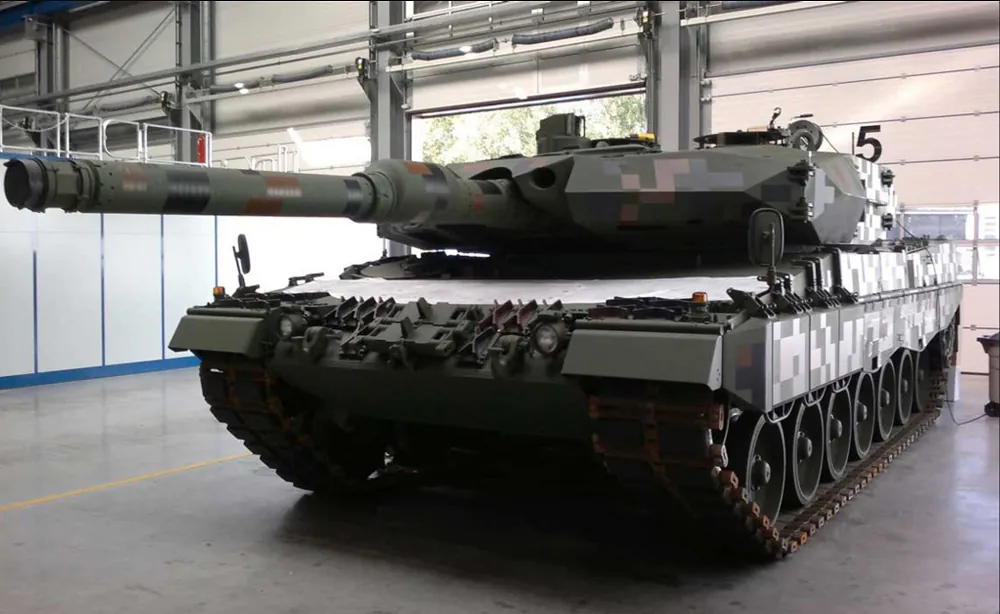
In this situation, Leopard 2 was developed. It was bigger, stronger, and more powerful than its predecessor. Compared to competing models, it resolved the basic conflict between protection, mobility, and firepower in the most convincing way. In terms of basic design, the Leopard 2 stood somewhere between Soviet tanks and those of the Western Allies. Models such as the T-72 are noticeably smaller, lighter, and more agile. The Abrams from the United States, on the other hand, is heavier and less mobile.
Some interesting facts about the development of Leopard 2 tanks. In 1977, the German army chose Krauss-Maffei as the main contractor for the serial production of the Leopard 2 and placed an order for the production of 1800 tanks, 990 of which were to be built by Krauss-Maffei itself, and the remaining 810 tanks were to be produced by Rheinmetall. Why did the Bundeswehr decide this way? Because they were in a hurry, as the tanks were needed urgently. The first pre-production Leopard 2 MBT was delivered to the German army training ground at the end of 1978, where it was successfully tested and approved. The first production Leopard 2 was delivered by Krauss-Maffei in October 1979. Only six tanks were delivered in 1979, 100 in 1980, 220 in 1981, and by 1982 production was 300 tanks per year. Today, the Leopard 2 is in service with countries such as Austria, Canada, Chile, Denmark, Finland, Germany, Greece, the Netherlands, Norway, Poland, Portugal, Singapore, Switzerland, Sweden, Spain, Turkey, and the United Kingdom, with a total of 3,200 vehicles in various modifications.
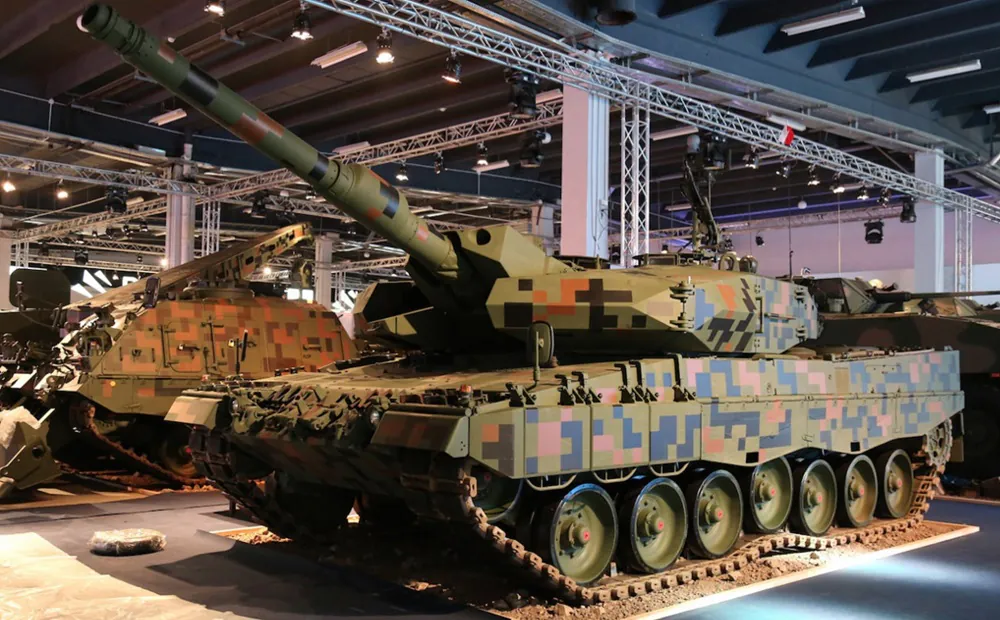
Referring to information published on May 20, 2022, the Czech Republic confirmed that Germany would supply it with Leopard 2A4 tanks in exchange for the transfer of Soviet T-72s to Ukraine. On June 5, 2022, Spain announced the receipt of 40 Leopard 2A4 tanks. On November 15, 2022, the German company Rheinmetall announced the delivery of Leopard 2A4s to Slovakia. On December 19, 2022, the Slovak Ministry of Defense received the first Leopard 2A4 tank from Germany. And now these combat vehicles will also come to Ukraine.
Read also: Weapons of Ukrainian Victory: Iris-T SLM for Ukraine from Germany
Variety of options
As I mentioned above, production of the Leopard 2 began in 1978. Over a long period of time, different versions of this tank were developed for different customers. In addition, large-scale modernizations were repeatedly carried out. So today there are a large number of variants in service, because not all old tanks have always been updated. In addition to tanks that are fully operational and in combat service, there are also large stocks of vehicles of varying degrees of preservation.
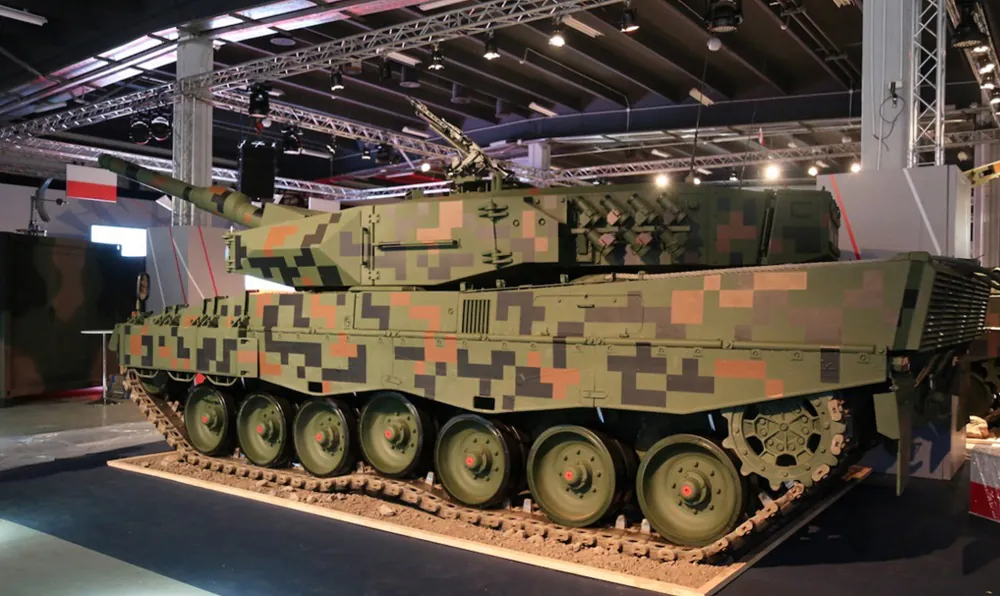
But let’s take a quick look at the main options for Leopard 2:
- Leopard 2 base version: the first version of the tank developed by Krauss-Maffei Wegmann and put into service with the Bundeswehr.
- Leopard 2A1: the first modernization of the Leopard 2 base tank, which received a number of minor improvements, including a thermal imaging gunner’s sight, improved protection, and new ammunition.
- Leopard 2A2: this tank model received a new thermal imaging sight, a deflector plate for the periscope and a larger hatch that provided better protection for the existing CBRN protection system.
- Leopard 2A3: the main change was the addition of SEM80/90 digital radios (installed on Leopard 1 as well) and welded ammunition reloading hatches.
- Leopard 2A4: the most common version of the Leopard 2 family as of 2023. The Leopard 2A4 models have more significant changes, including an automated fire suppression system, a fully digital fire control system capable of handling new types of ammunition, and an improved turret with flat titanium/tungsten armor. It is this version that I will discuss in more detail below.
- Leopard 2A5: The A5 variant received wedge-shaped spaced additional armor on the front of the turret and the front of the sides. These tanks also received some improvements in the main armor composition. The interior of the tank received additional protection to reduce shrapnel in case of armor penetration. The “heavy” third of the side sills was replaced with a new, stronger one made of a special alloy.
- Leopard 2A6: This tank was the first to receive the 120mm Rheinmetall L55 smoothbore gun and a number of other changes. There is also a version of the Leopard 2A6M with enhanced mine protection under the chassis and a number of internal improvements to increase survivability.
- Leopard 2PSO: This version was developed specifically for urban warfare, which is often the case in peacekeeping operations. The Leopard 2 PSO is equipped with more effective all-round protection, an additional weapon station, improved reconnaissance capability, a bulldozer blade, a shorter gun barrel, non-lethal weapons, close-range surveillance capability (through camera systems), a searchlight, and improved mobility.
- Leopard 2A6EX: A further development of the Leopard 2A6 was the improved Leopard 2A6 EX model, which was developed by a private enterprise for the export market. It has a number of additional improvements, including an auxiliary power plant, air conditioning unit and improved armor protection.
- Leopard 2A7: this variant is designed to operate in both low- and high-intensity conflicts, i.e., as close to the conditions of military operations as possible. This is a state-of-the-art version of the Leopard 2, and its development and improvement is still underway. The Leopard 2A7 has received a number of interesting improvements. In particular, the tank’s protection has been enhanced by modular armor, and the frontal protection has been improved by a double set of armor on the turret and front of the hull. The 360° protection against RPGs and mine protection increase the tank’s survivability in urban environments. This tank can fire programmable high-explosive munitions, and the MG3 mounted on the turret has been replaced by a stabilized remote-controlled FLW 200 combat station. Mobility, stability and situational awareness have also been improved.
Read also: Weapons of Ukrainian Victory: Modern PzH 2000 self-propelled howitzers
Armament of Leopard 2A4
As I promised, I decided to pay special attention to the most common version of the German Leopard 2A4 battle tank in my article.
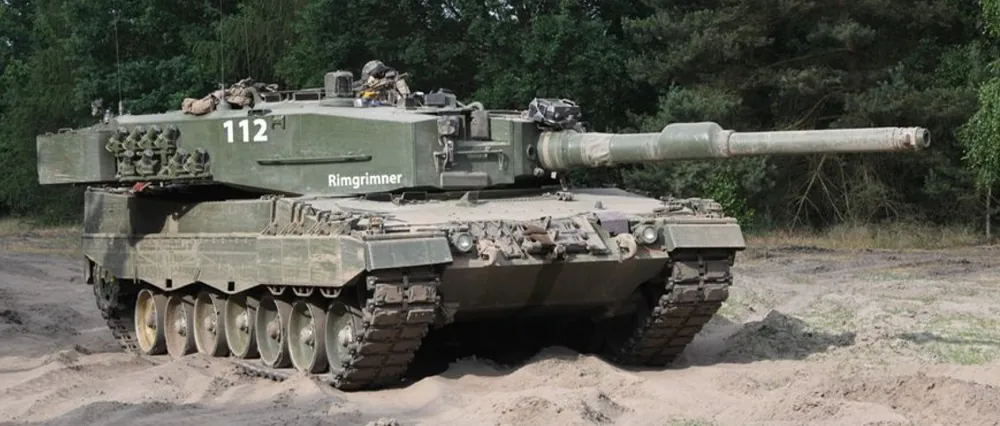
The Leopard 2A4 is armed with a 120-mm smoothbore gun developed by Rheinmetall. This allows the use of two types of ammunition, APFSDS-T and HEAT-MP-T. The former, APFSDS-T, has an effective range of over 2000 meters, while HEAT-MP-T has a high degree of effectiveness against a variety of targets. Both stabilized projectiles have a semi-flammable metal-backed case that is ejected into a box under the breech.
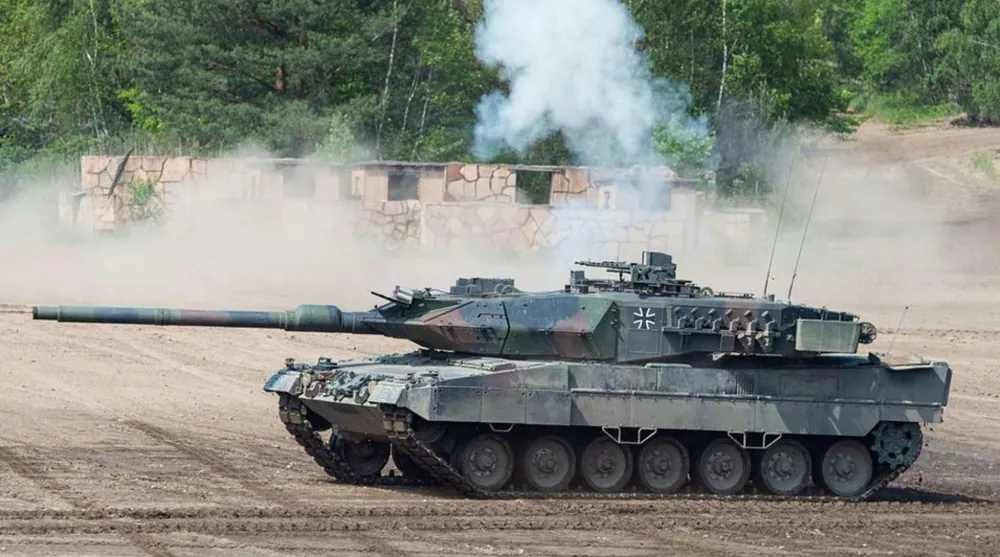
The Leopard 2A4 has a total of 42 rounds of ammunition: 27 of them are stored to the left of the driver’s side, and 15 are stored in the left side of the turret, which is separated from the combat compartment by an electrically operated door. A 7.62mm twin machine gun is mounted to the left of the main armament, and another 7.62mm machine gun is mounted near the loader hatch. Two sets of four 76-mm smoke grenade launchers are mounted on each side of the turret. The Leopard 2A4 is equipped with a computerized fire control system that has a maximum range of 10,000 meters with an accuracy of 20 meters at this distance. The combined system allows the Leopard 2A4 to engage moving targets at a range of up to 5,000 meters.
Read also: Weapons of Ukrainian Victory: Aspide Anti-Aircraft Missile System
Engine and mobility of the Leopard 2A4
The Leopard 2A4 tank is powered by the MTU MB 873 diesel engine, which provides 1103 kW of power. The 47.6-liter MTU MB 873 diesel engine is a four-stroke, 12-cylinder, turbocharged, liquid-cooled engine. Thanks to this powerful engine, the Leopard 2A can reach a maximum highway speed of 72 km/h with a maximum range of 550 km.
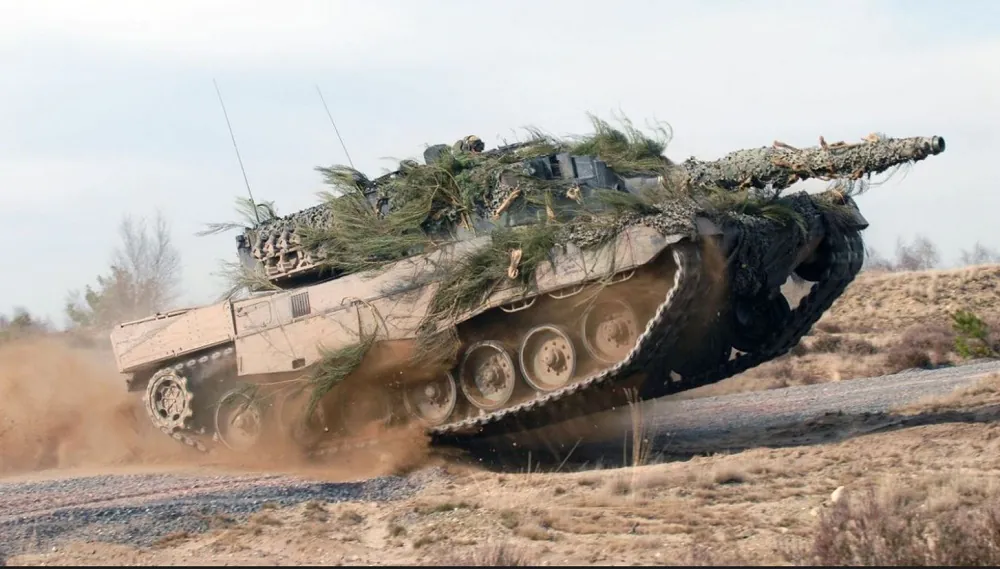
The Leopard 2A4’s torsion suspension on each side consists of seven twin rubber-tired support rollers with a tensioning wheel in the front, a drive sprocket in the rear and four support rollers. The tank is capable of overcoming a slope of up to 60% and a side slope of up to 30%.
Reliable armor
The Leopard 2A4 is not a heavy tank. It can be considered a medium tank, although it has powerful armor and a variety of modern protection.
The Leopard 2A4’s hull has spaced multi-layer armor and is divided into three compartments: a place for the driver’s mechanic in the front, a combat section in the center, and a power section in the rear. Some variants of the Leopard 2A4 are equipped with additional armor to increase crew protection against mines and improvised explosive devices. The driver is located at the front right. The turret is mounted in the center of the hull, with the commander and gunner on the right and the loader on the left.
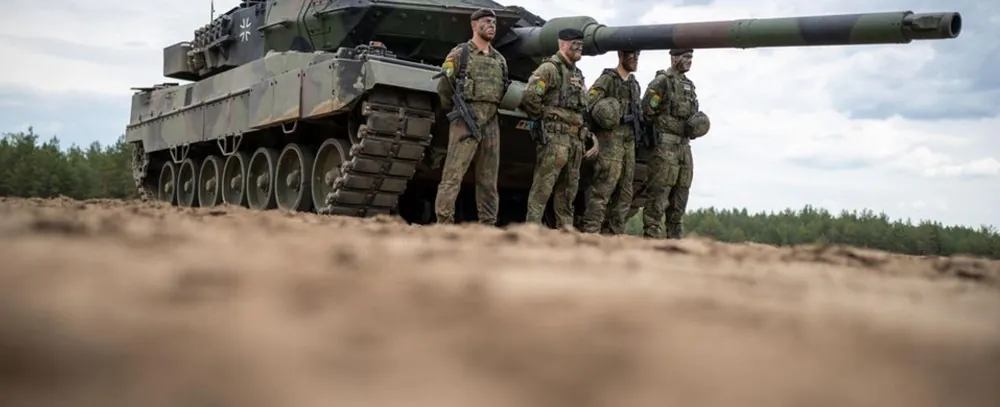
The commander is equipped with a hatch with a round lid that opens to the rear and periscopes for all-round visibility. The loading system is located on the left side of the turret.
Read also: Weapons of Ukrainian victory: ATGM Stugna-P – Russian tanks are in trouble
Modern equipment of Leopard 2A4
After a number of improvements and modifications, this variant of the Leopard 2 tank became quite popular and widespread.
The standard equipment of the Leopard 2A4 includes a preheated power supply, a crew compartment heater, a fire extinguishing system, electric dewatering pumps and an emergency hatch in the bottom of the hull behind the driver. The Leopard 2A4 is also equipped with the NBC overpressure system, which provides an overpressure of up to 4 mbar (0.004 kPa) inside the combat vehicle. The Leopard 2A4 can overcome water obstacles up to 4 meters deep with a snorkel or 1.2 meters without any training and overcome vertical obstacles over 1.1 meters.
Read also: Weapons of Ukrainian Victory: NASAMS air defense that protects Washington
Polish Leopard 2PL version
But I was more interested in the Polish Leopard 2PL because the first German battle tanks will come from Poland. There is a high probability that they will be the first to be used by the Armed Forces of Ukraine. So, let’s get to know them better.
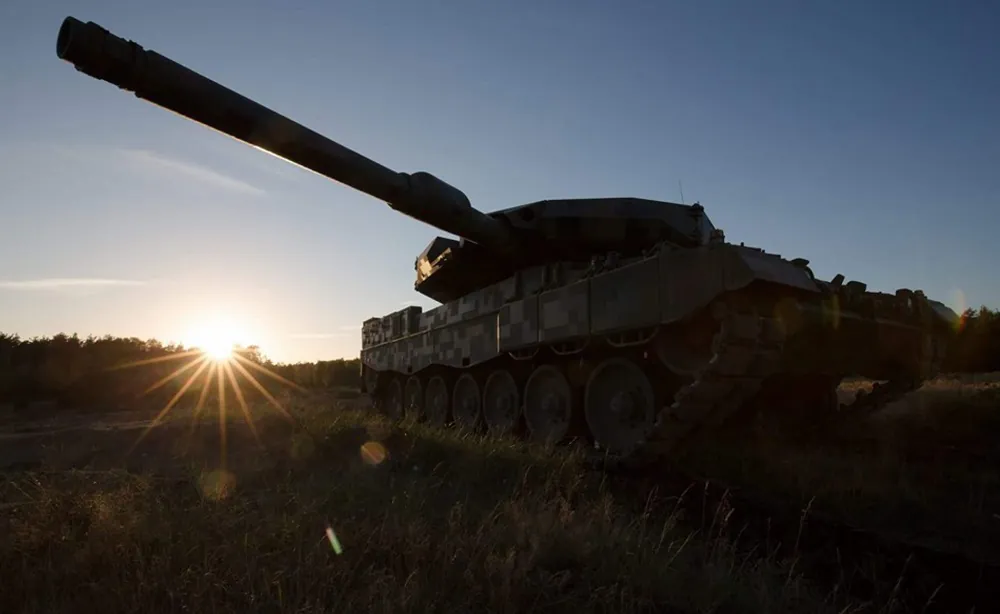
In 2002, Germany presented Poland with 128 Leopard 2A4 tanks from the German army. And in 2013, the German Ministry of Defense signed a contract with Poland, under which it received 14 more Leopard 2A4 tanks, as well as 105 new Leopard 2A5 tanks and Bergepanzer 2 armored evacuation vehicles from the Bundeswehr.
Upgrading Leopard 2A4 to Leopard 2PL
In 2015, the Polish Ministry of Defense selected the German company Rheinmetall to modernize old Leopard 2A4 tanks. The upgraded version was developed by Rheinmetall in cooperation with a number of Polish companies. The upgraded tanks were named Leopard 2PL. The first demonstration tank was first presented and tested at a training ground in 2016. In 2018, a contract was signed to upgrade 142 Polish Leopard 2A4 tanks to the Leopard 2PL standard. The first modernized tanks were delivered to the Polish Army in 2020. Deliveries are scheduled to be completed by the end of 2023.
How many tanks are in service in Poland?
Currently, the Polish Army has eleven fully equipped tank battalions. Two of them are armed with Leopard 2A5 tanks. Two more are equipped with Leopard 2A4 tanks, which are planned to be upgraded to the Leopard 2PL standard over time. There are also four battalions equipped with PT-91 Twardy tanks and three battalions equipped with old Soviet T-72M1 tanks. In total, the Polish army has 233 PT-91 tanks and 120 T-72M1 tanks in service. Another 470 T-72M1 tanks are in storage.
Read also: ‘Neptunes’ knocked out ‘Moskva’ cruiser: All about these anti-ship cruise missiles
Leopard 2PL vesrion
The Leopard 2PL upgrade is broadly similar to the Revolution MBT modular package for the modernization of the Leopard 2A4 main battle tanks by Rheinmetall. The tank received improved armor protection, an improved cannon, improved sights and some other systems. However, despite all the improvements, the Polish Leopard 2PL is not as powerful as the updated Leopard 2A7, which was modernized by Krauss-Maffei Wegmann and entered service with the German army in 2014. The Leopard 2PL is inferior to the Leopard 2A7 in key aspects of protection, firepower, accuracy and equipment with on-board electronic systems.
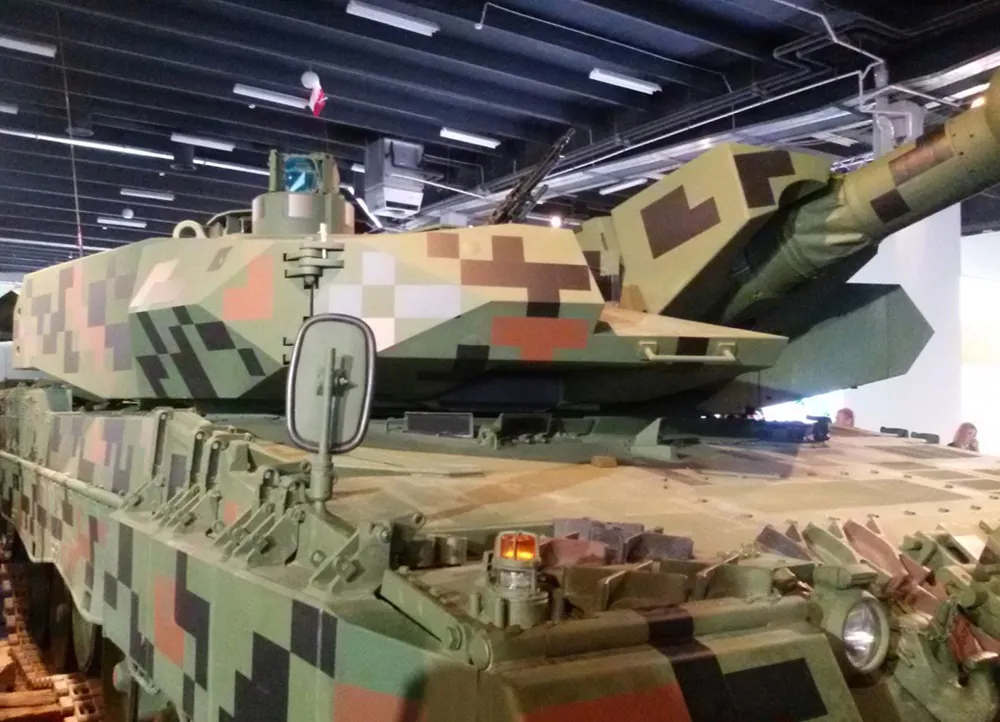
But if we compare it with the Leopard 2A4, the Polish Leopard 2PL has improved armor protection. The turret is fitted with the AMAP (Advanced Modular Armor Protection) composite armor kit developed by the German company IBD Deusebroth. This armor is part of the Rheinmetall Revolution upgrade package. New nanoceramic materials and modern titanium and steel alloys are used to create it. This armor provides a higher level of protection against a wide range of threats. The Leopard 2PL armored turret provides greater protection than the Leopard 2A5 turret, but it cannot match the level of protection of the Leopard 2A7. The armor set is modular, so damaged armor modules can be replaced with new ones in the field. It is planned that AMAP armor modules will be produced in Poland under license.
However, the Leopard 2PL is slightly heavier than its predecessor. It weighs 60 tons, compared to 56.6 tons of the original Leopard 2A4. About 3 tons of additional armor was added to the turret at the front and sides of the tank. The hull, however, did not receive additional armor in order not to exceed the weight limit of 60 tons set by the Polish Army. Some sources report that the tank is also equipped with additional armor under the hull to improve protection against mines and improvised explosive devices. Leopard 2PL crew members are seated on new anti-shock seats.
Poland’s Leopard 2A4 tanks have hulls dating back to the early 1980s. It seems that these hulls will not be able to withstand modern ammunition, such as armor-piercing sub-caliber feathered tray shells of the APFSDS class.
Read also: Weapon of Ukrainian Victory: German Self-Propelled Howitzer Boxer RCH 155
Modern weapons
The Leopard 2PL tank retains the 120mm/L44 smoothbore gun from its predecessor. However, the gun barrel has been modified by Rheinmetall to be compatible with newly developed high-pressure ammunition such as the DM11 programmable high explosive munitions and DM53 and DM63 armor-piercing rounds. The programmable munitions allow for engagement of targets behind cover and inside buildings. These multi-purpose DM11 rounds can also be used against concentrations of enemy troops, armored vehicles and low-flying helicopters. The cannon can also fire any other standard NATO 120 mm tank ammunition. The cannon is loaded manually by a loader. In total, the tank holds 42 rounds, just like the Leopard 2A4. At the same time, 15 shells are stored in the turret and are ready for use. The rest of the ammunition is stored inside the hull.
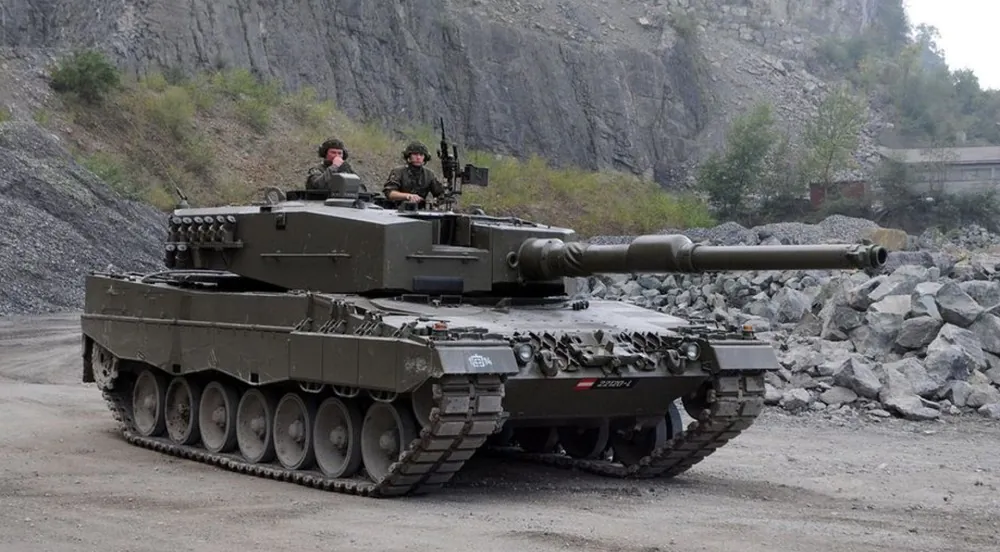
The tower’s hydraulic drives were replaced with an electric drive. This modernization significantly increases survivability after penetration, as the hydraulic drive contains flammable liquid.
The auxiliary armament consists of twin 7.62 mm machine guns, with another 7.62 mm machine gun mounted on the roof.
The Leopard 2PL has advanced sights and a fire control system. The commander uses a panoramic sight, which is equipped with a Polish-made thermal imager and contains a laser rangefinder. The commander’s post is equipped with a number of digital screens that display various information.
It seems that the Leopard 2PL is a so-called “hunter-killer” like all modern main battle tanks. This means that the tank is equipped with dual independent sights and auxiliary fire control equipment/software that allows the gunner and commander to track and destroy two separate targets simultaneously. Obviously, the gun turret cannot point in two directions at the same time, but it allows the tank crew to simultaneously track the second target and perform all fire control calculations while it is destroying the first target.
This process works like this. The commander uses a panoramic sight to search for targets. After selecting a target, the gun is automatically aimed at the target, and the gunner completes the entire process of aiming and firing. Meanwhile, the commander is looking for the next target. This method of engagement allows for faster target acquisition and engagement.
The driver received a new night vision sight for driving at night and a rearview camera that makes reversing much easier.
Read also:
- Weapons of Ukrainian victory: French Crotale SAM
- Silent killers of modern warfare: most dangerous military UAVs
Other improvements
Despite all the upgrades, the Leopard 2PL’s communication systems remained unchanged. This tank also lacks a battlefield management system.
The Leopard 2PL main battle tank is operated by a crew of 4 people: a commander, a gunner, a loader and a driver.
The Leopard 2PL retains the engine of its predecessor. It is equipped with a turbocharged MTU MB 873 Ka501 diesel engine that develops 1500 hp. This tank is also equipped with a Steyr auxiliary power unit (APU) that powers all systems when the main engine is off. The same modern auxiliary power unit is also used on the state-of-the-art Leopard 2A7. The cross-country ability is the same as its predecessor. This tank can be equipped with a fording kit and can cross shallow rivers, lakes and other water obstacles up to 4 meters deep.
Read also: All about the General Atomics MQ-9 Reaper
Specifications of Leopard 2A4
- Dimensions: length 7.7 m; width 3.7 m; height 3 m
- Armor: standard spaced multi-layer armor, improved armor protection over the front of the turret, the inner part of the turret is equipped with additional protection
- Armament: 120-mm L55 smoothbore gun, twin 7.62-mm machine gun and anti-aircraft 7.62-mm machine gun
- Weight: in combat condition 62 tons
- Top speed: 72 km/h
- Operational range: 500 km
- Capacity: 4 crew members (commander, gunner, loader and driver)
- Additional equipment: infrared night vision, NBC protection system.
How much does a Leopard 2 tank cost? Of course, it all depends on the modification. For example, the new Leopard 2A6 costs about $6.79 million, while the price of the Leopard 2 A7+ can reach $10 million.
Read also: Invasion of Ukraine: Bayraktar TB2 strike UAV review
Why do we need tanks?
We first heard about possible tank deliveries at a Pentagon briefing on September 19, when a representative of the US Department of Defense said that tanks were the subject of negotiations with the Ukrainians, but since then the Ukrainian Armed Forces have not received any heavy Western armored vehicles.
The current approval of the Leopard 2 delivery to Ukraine by the US demonstrates a more active position on this issue by Washington, which called on Berlin to start helping Kyiv with heavy weapons.
It is well known that over the past half century, tanks have been “written off” after almost every military conflict. With the emergence of new highly effective infantry anti-tank weapons such as the American FGM-148 Javelin grenade launcher or the British NLAW, and with the active use of artillery fire control drones on the battlefield and the use of precision-guided shells by artillery, it seems that the tank has become a mobile target rather than a weapon.
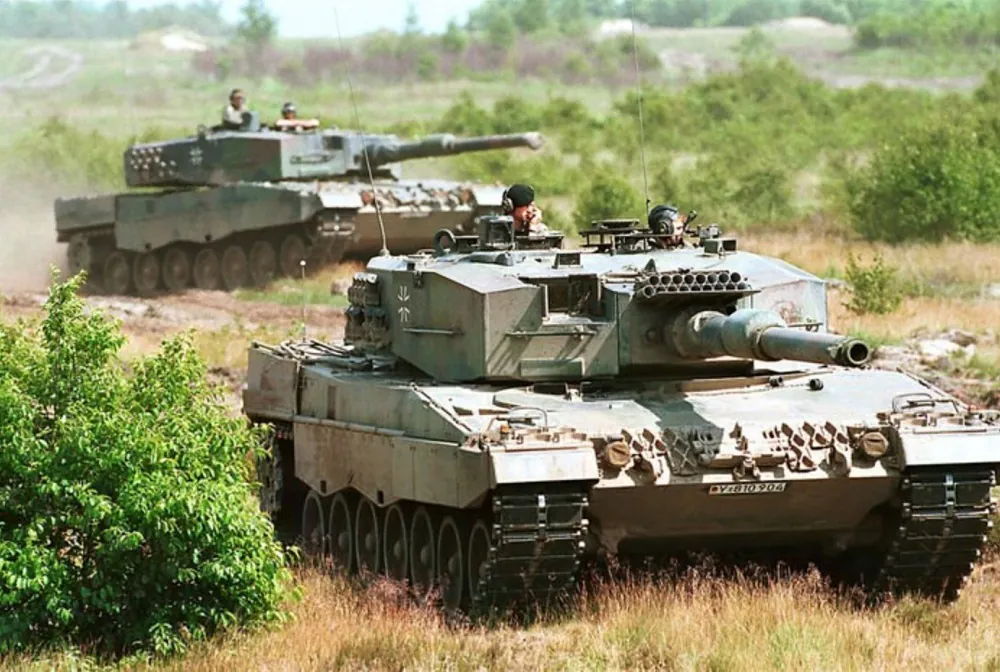
Compared to any shot from a grenade launcher and any sophisticated precision projectile, the cost of a tank is incomparably higher, and sometimes it can be destroyed with a single shot.
Russia’s war against Ukraine, where both sides are posting videos of tanks being destroyed on social media, has become a kind of showcase for anti-tank grenade launchers, further damaging the reputation of tanks.
However, manufacturers did not lose interest in tanks, and several months after the outbreak of the war, first the German company Rheinmetall and then the American company General Dynamics presented new developments.
The fact is that there is still no alternative to the tank on the battlefield. It is the center of an infantry strike group in any theater of operations: in the field, in urban areas, in difficult terrain. It is possible to create a cheaper combat vehicle to solve specific tasks, such as supporting infantry in an attack, fighting armored vehicles and fortifications, and defending borders. But the tank is the only universal vehicle capable of solving all these and many other tasks.
We must understand that the mere appearance of Leopard 2 tanks on the battlefield will not make the Ukrainian army stronger overnight. A tank is only a part of the system, and improving a single component does not automatically lead to improving the system as a whole. Air defense, artillery, intelligence, tanks – if we improve only one component, there will be no proportional growth. But the mere appearance of heavy equipment and tanks will additionally testify to the support of our Western partners, their desire to help us, and their trust in our victory.
We believe in our defenders. The invaders will not escape from retribution. Death to the enemies! Glory to the Armed Forces! Glory to Ukraine!
Read also:
- Weapons of Ukrainian Victory: The SAMP/T Anti-Aircraft Missile Complex
- Weapons of Ukrainian Victory: Turkish-Made MRAP Kirpi
- Weapons Of Ukrainian Victory: MRAP International MaxxPro By Navistar Defense

